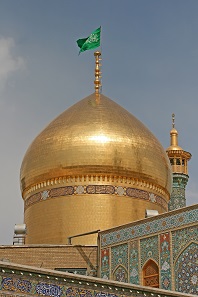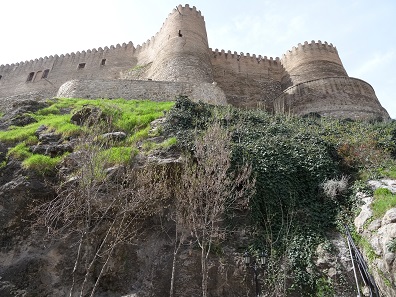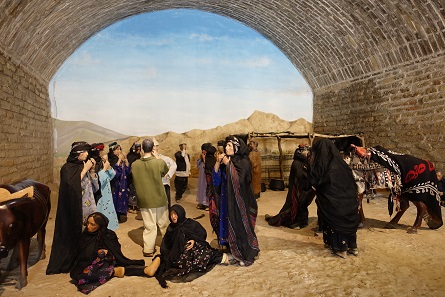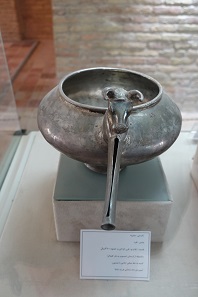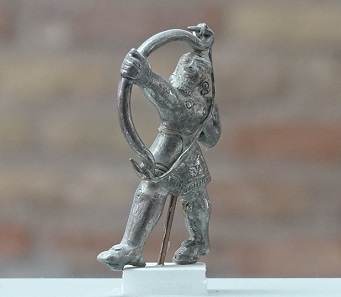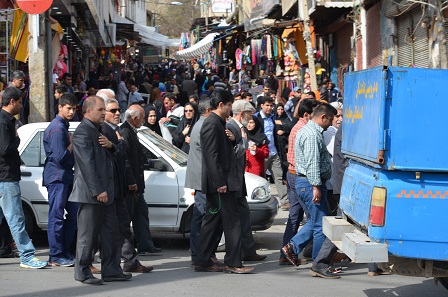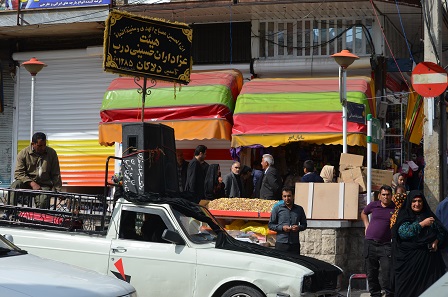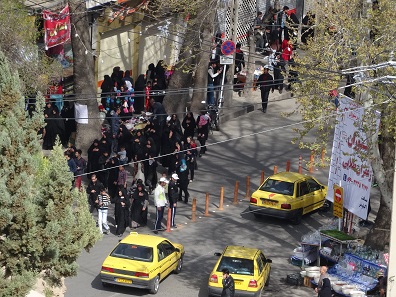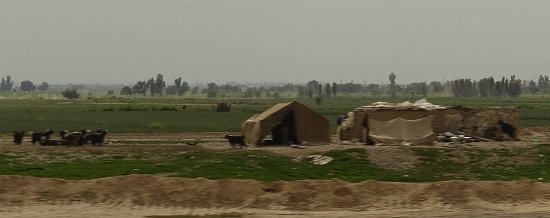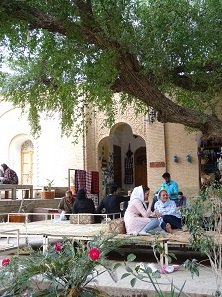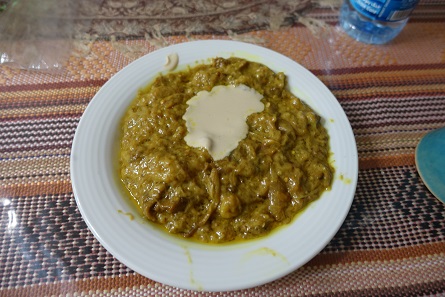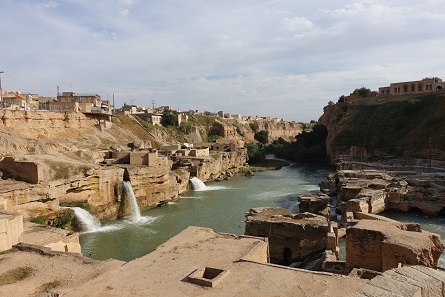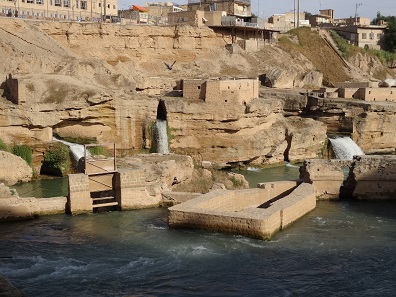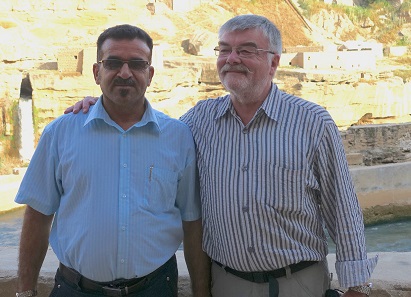by Ursula Kampmann
translated by Teresa Teklic
1 September 2016 – After Mashhad Qom is the second most important religious centre of the Shiites in Iran. Tens of thousands of pilgrims come to visit this place, above all to see the Shrine of Fatima Masumeh. This figure of Shiite tradition, rarely known in the West, was the daughter of the seventh Imam and the sister of the eighth. Of course she is attributed all female virtues today. What’s more, she is also said to have been very educated and wise.
When her brother was exiled, she followed him, leading a caravan of 12,000 people. But their followers were attacked and many people killed. Fatima Masumeh was forced to witness the assassination of more than 23 friends and family members. She was poisoned not much later. When she felt death was near she asked to be taken to Qom.
Golden dome of the Fatima Masumeh mausoleum. Photo: Muhammad Mahdi Karim / Wikipedia. – Many thanks for the permission for publication so quickly granted.
She died there on November 7 or 9, AD 816. Her death is remembered by Shiites around the world until this day with processions and prayers. In Iran this took place on Sunday, 13 March 2016. Which we didn’t know yet when we got on our way to Khorramabad.
Sunday, 13 March 2016
Getting up at 6.45 am was practically having a lie-in for us. After a spartan breakfast we took off at 7.30. Not a minute too late since the drive from Borujerd to Ahvaz is pretty long. There wasn’t much traffic since it was a Shiite holiday, the day of death of Fatima Masumeh. We watched from our bus window how a few believers began to put up the grandstands where people would later lament and celebrate. The great majority, however, seemed to do what most people in Catholic Bavaria do every Easter Sunday – seize the holiday for an extended beauty sleep.
Luristan bronze in the museum of Khorramabad. Photo: KW.
We on the other hand were on the bus and driving through Luristan. Of course there were explanations for the famous Luristan bronzes. I admit that, for the first time, I understood why people fight so vehemently for the use of politically correct language. At least it raises awareness about what you say and how you say it. The term “illicit excavation” is thoughtlessly overused today for about everything that hasn’t gone through the pure hands of noble archaeologists.
This term was used about 150 times in half an hour (at least it felt like it) and each time I would have loved to ask a few questions: a) What exactly was the legal situation between 1850 and 1900 according to Qajar law in the Persian Empire? b) Who was the original owner from whom the pieces were stolen? And should you really condemn Luristan farmers, who have lived in their homeland for thousands of years and are still clearly recognisable on the streets today due to their typical traditional dress, because back then they set out to look for the bronze, found it, and rather sold it to dealers than behave like good and law-abiding citizens and give it to the Qajar government? c) Which archaeologist would have ever gotten the idea of conducting even a single excavation in Luristan if the bronzes hadn’t attracted the attention of the professional world? d) How many of the Luristan bronzes currently located in Iran have been appropriately dealt with in academic publications?
But all of these questions would have probably been too complex for us tourists. (Even politicians often seem unable to understand that times and values can change.) And then it is simply easier to see the world black and white: on the one hand the noble archaeologists, on the other hand the bad, bad criminals – whoever this was supposed to be …
View of the Falak ol-Aflak castle in Khorramabad. Photo: KW.
To cut a long story short, we arrived in Khorramabad at 11 am. Honestly, I didn’t expect too much. Although the castle had been built under Sassanid rule already (it was called Shapur Khwast at the time), no trace of this is left today. Instead we get a Safavid castle, built during the reign of Abbas I. Sure, it too looks kind of nice from below, but up there it’s pretty average.
Ceremony of mourning in Luristan. Photo: KW.
It hosts an ethnological museum that is surprisingly spacious and its interior decorated with surprisingly great care. Many photos, many artefacts, several highly interesting models and everything explained in German and English. Now the only thing this museum lacks is crowds of tourists waiting to get in.
And if this museum was in an easily accessible, tourist-proof city, there would be crowds pushing to get in because there is an incredible highlight …
Cup with five striding lions. Photo: KW.
… an Aechemenid silver treasure discovered several years ago, whose quality should not be underestimated!
Goat-shaped drinking vessel. Photo: KW.
We revelled and marvelled and learnt when we asked about it that the treasure trove had of course not been published.
Cicada bowl. Photo: KW.
Perhaps it will be one day (if all those who could provide information on the details of its discovery are dead?). It was supposed to be shipped to Tehran to go on exhibition in the national museum.
Silver vessel with a bull-shaped spout. Photo: KW.
Fortunately that never happened. Here it is on display at least. If it was to enter the so-called “treasure room” of the National Museum of Iran, it would disappear from the earth for a while since this “treasure room” has not been reopened for “reasons of security” – says Mahmoud Rashad in his Iran travel guide from the Dumont art travel guide series.
Silver archer, c. 8-10 cm high. Photo: KW.
So a whole lot of significant discoveries are resting there. Let’s hope that they will all still be in the depot for a potential reopening.
Procession in honour of Fatima Masumeh. Photo: Sigrid Hodel.
Anyhow. We left the castle and stumbled right into a small procession in honour of Fatima bint Musah. It was memorable! First came a band with trumpets and drums like we had just seen them in the ethnological museum. It was followed by several believers, dressed in deep black, the black garments smeared with clay, wailing, lamenting.
A transporter with a big speaker on the roof that emitted very loud and unmistakably religious music. Photo: Sigrid Hodel.
Right in the middle of the procession drove taxis and transporters with loud speakers installed on their roofs. They emitted very intense, religious music. They were followed by more believers. It was pretty memorable and seemed to us like a glimpse into the distant past.
Taxis in the midst of the procession. Photo: KW.
Somewhat intimidated we watched the procession and the Khorramabadians (or whatever the correct term is) watched us. Some of them very benevolently. Christine had bad luck. Her headscarf slipped off – I could write books about our fight with the headscarves. She startled and pulled it back up. A Muslim woman observed her. She was one of the progressives. Easily recognisable thanks to the headscarf that she wore far back and the blond highlight in her hair. She stroked Christine’s arm to comfort her and pulled her own headscarf back even further to demonstrate her solidarity. Then she smiled at me, pointed at the believers and made an internationally comprehensible sign to indicate that she thought the procession pretty stupid.
So much about the claim occasionally put forward by the media that Iran is exclusively populated by fanatics. What nonsense! There are – just like everywhere on earth – believers, not quite so serious believers, fanatic believers, and non-believers …
Unfortunately only a snapshot from the bus and hence not particularly sharp. Photo: KW.
From Khorramabad we took off to cross the Zagros Mountains. The landscape on this drive was truly beautiful so that we would have liked to stop and take a few pictures. Unfortunately that doesn’t work quite as easily on a bus as with your own car. So we drove past the many nomad tents. Yes, they really do still exist, those nomads who move across the mountains with all their possessions. Life’s not easy for them. No government enjoys it if it doesn’t know where to dispatch its citizens’ tax statements. But at the moment it seems like there is a politics of tolerance in Iran according to our travel guide Ms Hodel. Yes, one even tries to provide some kind of public-school education for the nomad children.
Driving across a stunning landscape. Photo: KW.
The ride was fantastic. Still, after a while we noticed a nagging feeling of hunger (it had already been five hours since the meagre breakfast). One hour later the sound of our rumbling stomachs had grown into a harmonious chorus. Yet an hour later everybody had rummaged their backpacks for the last edible provisions, which may have been hidden in there. And some time shortly before 3 pm, when nobody still believed in it, a restaurant came in sight. And what a restaurant! A special class restaurant.
In the house of a wealthy merchant from Shushtar the Iranian Cultural Heritage Organization hosts a fantastic restaurant these days. Photo: KW.
It was the most beautiful lunch of our trip – and it was worth every minute of waiting time. In the house of a rich merchant from Shushtar, which is today owned by the Iranian Cultural Heritage Organization, a fantastic restaurant has been set up, which is frequented less by tourists than by wealthy Iranians. Accordingly most guests here take their food on the small platforms on which you dine half-seated, half-lying. But there were also two European rooms with tables and chairs. We decided in favour of tables and chairs because, let’s be honest, the food goes down much more easily when you’re sitting upright because our muscles are used to it.
Finally, vegetables! A dish with aubergines. Photo: KW.
It was delicious! For starters we had yogurt, bread, mint, and leek, followed by some sort of Iranian meatballs, mashed aubergines, a dish with mutton and chick peas as well as a curious variation with plums and meat. With the latter you had to eat very carefully because the plum stones were still in the plums. We feasted! And got to know many of the other guests.
Emperor’s Bridge, the most eastern bridge of Roman architecture. Photo: KW.
While we had tea we took a look at the famous bridge right in front of our restaurant. It has the beautiful name Polband-e Qaysar, Emperor’s Bridge, and parts of it actually date back to Sassanid times. It is called Emperor’s Bridge because it is said to be built by the Romans, who ended up in captivity together with Emperor Valerian. In fact the bridge is known among historians with an expertise in architectural history as the most eastern bridge built with Roman construction technique…
Shushtar water mills. Photo: KW.
Our last point on the agenda were the water mills of Shushtar, to which the Dumont art history travel guide – despite its status as UNESCO world heritage site – dedicates a whole of nine lines. And it isn’t the only one. There is little information available on this engineering marvel whose artificial water falls have likely been used for energy production on the one, for irrigation of the adjacent farmland on the other side of the Gargar River since Sassanid times.
Canals and blockable spouts regulate the water flow. Photo: KW.
The complicated structure of small canals and dams dates back to Safavid times even though hardly anything has been preserved in its original state. What you see today has been reconstructed after this world heritage site was almost entirely destroyed in the war between Iran and Iraq.
The Iranian people love this gurgling paradise, especially on a beautiful holiday such as this. Consequently we tourists from abroad were clearly outnumbered. Whole busloads of young girls in black chadors were carted to the water mills, where they behaved just like young girls without black chadors behave in our country. They giggled and were apparently discussing our Western dress. I wouldn’t be surprised if we’d started one or the other new fashion trend.
Iranian-Swiss fraternization. Photo: UK.
And don’t you think that it’s always the tourists taking pictures of the locals. We were the much more popular motif. We couldn’t go five steps without being asked about our wherefrom and whereto. Again and again we were asked to pose for a group picture. And every conversation, be it ever so short, ended with the obligatory “Welcome to Iran!”
It didn’t take much longer until we arrived at the hotel. And Ms Hodel faithfully promised that it would be quieter from now on. And we did stay in a five-star hotel in Ahvaz, even by Western standards – at least for two nights. I admit it was a great temptation to stay in my hotel room the next day, complete the missing parts in my travel diary, do my laundry, and get some rest. If it hadn’t been Susa of all places on the programme, I might have given in to temptation. At least we didn’t start before 8 am the next day.
In our next episode we see a flawlessly preserved Ziggurat, visit Daniel in the lion’s den, and take a tour of Shush castle.
You can find all episodes of my Iranian travelogue here.



